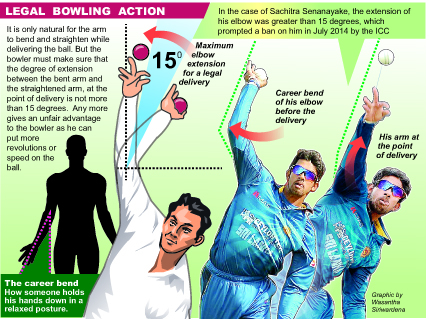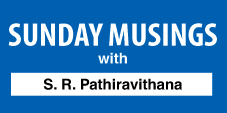Combating Lanka’s Chuck Norris syndrome
View(s):Is it a cultural difference or is it a matter of utter callousness. In England, a bowler being called for chucking even at county level is a rarity. In Australia since the conundrum involving Ian Meckiff, the left arm seamer who represented the country from 1957 to 1963, no other bowler has come to limelight with a suspect action at first class level. Yet, in Sri Lanka, more than one hundred bowlers have been reported for having this syndrome.
As a matter of fact, in England and Australia, the system does not encourage suspect bowling actions. Around five years ago, India too joined the zero tolerance club and they too went into arbitrary actions such as banning the bowler and fining his coach. The word spread around and in India too there are almost no incidents of bowlers being reported at international level, in the recent past.
Ironically, these are the three nations who have hijacked the International Cricket Wagon and are injecting their style of activity into the process, but, their intolerance of suspect bowling action is one of the good things that have been put into force, even with some questions marks at hand.
Last week began with SLC’s spin bowling Coach Piyal Wijetunga stating that Sachithra Senanayake – the Lankan off spinner who was reported for suspect bowling action during Sri Lanka tour of England — was ready to make a comeback into the international fold.
 The Sunday Musings made this an opportunity to talk to the Max Academy Coaching Head, Jerome Jayaratne who accompanied Senanayake for (private) testing at the University of Western Australia and played a pivotal part in the rehabilitation of the bowler.
The Sunday Musings made this an opportunity to talk to the Max Academy Coaching Head, Jerome Jayaratne who accompanied Senanayake for (private) testing at the University of Western Australia and played a pivotal part in the rehabilitation of the bowler.

Our staff photographer Ranjith Perera captured Sachithra Senanayake operating in the Mercantile ‘A’ Division cricket tournament after the rehabilitation of his action
Yet, not only the Senanayake pose, but, the bent-arm problem is real in Sri Lanka. During our chat with Jayaratne we tried to cover as much areas as possible on the issue at hand.
Jayaratne explained that what the ICC was trying to do was not something new. He said the 15 degree tolerance level was already there in the statute book. There would have been some difference in the interpretation of it by international umpires, but now the law is put fully into effect and the umpires and the rest of the ICC machinery are at it. But, no new laws have been introduced or existing laws been removed.
What the ICC is looking at is if the bowler is extending his elbow at the point of delivery and straightening his arm. If that is happening they would accept a 15 degree move of the elbow and the buck stops there.
According to Jayaratne, now the ICC testing does not take the career bend into account. What they are only concerned about is how much a bowler extends his elbow at the point of delivery. The career bend is how one holds his hands down at a relaxed posture. The bend of one’s arm at that point is described as the career bend.
At the same time the ICC is not concerned about the flexing of the arm. Flexing is described as bending inwards — how a leg spinner delivers the ball. It is proven that one cannot throw a ball while flexing the arm.
Still world cricket has not been able to catch a bowler with a dodgy action in a match environment. A system of that nature still has not been developed. What happens at present is — once a bowler is reported for using illegal deliveries and once the ICC receives the footage of the bowler’s bad deliveries, the bowler is sent to an ICC accredited testing centre. Here the bowler is requested to bowl with the very same action as recorded in the footage and those deliveries are overlaid and the testing is done upon that. During the test, thirteen infrared cameras are focused on the bowler’s delivery. Then the experts do the calculations on the extension of the elbow and arrive at their diagnosis.
However, Jayaratne says what is wrong in this process is that the ICC, though it gives the verdict after the test that a bowler is extending his arm to a certain number of degrees, it does not explain the methodology on how they arrived at that conclusion.
It is believed that the ICC fears that if the modality is divulged, individual boards may challenge the ICC’s conclusions through other means.
Then once Senanayake came back into the island, SLC spin bowling coach Piyal Wijetunga worked on Senanayake’s action, especially on areas that prompted the bowler to straighten his elbow at the point of delivery. Jayaratne said, “When he is operating now besides the straightness of the arm you may not see any difference. But, a lot of cosmetic changes have been put into his new style of bowling.
“Even when we released him to operate in the Mercantile Cricket Tournament, there were certain deliveries that we were not happy with. There were instances that we had to go back to the remedial process. But now we are happy with his action and we have proposed that first he is exposed to a private test like what we did at the Western Australian University and once satisfied to put him back to the ICC test”.
Jayaratne added that once the remedial work has been affected upon a player, they are no longer worried about the original footage. They would only test his present action and if the deliveries are within the ICC stipulations they would give permission for him to bowl at international level.
The SLC-run Max Academy’s head also said, “Remember that the action that is passed is the action that the bowler is tested upon. He cannot deviate from it. By chance if the bowler is reported again and is proven to be extending his elbow, he will then face a stiffer ban.”
Now SLC also has purchased some ICC recommended cameras to do the initial testing of bowlers with suspect action. They have been on the trail of in local bowlers with suspect action for the past six months. So far they have detected more than one hundred bowlers and the Max Academy coaches are working on them. According to the Max Academy Chief, more than seventy per cent of the troubled bowlers are off spinners.
Jayaratne added, “At the initial stages, when we were checking upon some school cricketers — including schools with big names – school representatives, some accompanied by lawyers, came to meet us –. But, once we explain the gravity of the situation and the work we intend doing, they let us go through the rehabilitation process”.
In this process, educating the coaches at district level is the most effective remedy, Jayaratne asserts. He feels the message has to travel to all levels of the process and the SLC is now effectively on the job.


